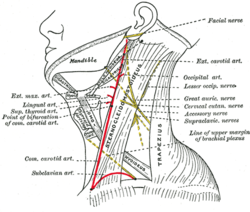- Occipital triangle
-
Occipital triangle 
Occipital triangle 
Side of neck, showing chief surface markings. (Nerves are yellow, arteries are red.) Gray's subject #145 565 The occipital triangle, the larger division of the posterior triangle, is bounded, in front, by the Sternocleidomastoideus; behind, by the Trapezius; below, by the Omohyoideus.
Its floor is formed from above downward by the Splenius capitis, Levator scapulæ, and the Scaleni medius and posterior.
It is covered by the skin, the superficial and deep fasciæ, and by the Platysma below.
The accessory nerve is directed obliquely across the space from the Sternocleidomastoideus, which it pierces, to the under surface of the Trapezius; below, the supraclavicular nerves and the transverse cervical vessels and the upper part of the brachial plexus cross the space.
The roof of this triangle is formed by the cutaneous nerves of cervical plexus and the external jugular vein and platysma muscle
A chain of lymph glands is also found running along the posterior border of the Sternocleidomastoideus, from the mastoid process to the root of the neck.
Gallery
See also
External links
- lesson6 at The Anatomy Lesson by Wesley Norman (Georgetown University)
This article was originally based on an entry from a public domain edition of Gray's Anatomy. As such, some of the information contained within it may be outdated.
Head Neck Thorax Triangle of auscultation · axillary folds (Anterior, Posterior) · Clavipectoral triangle · Inframammary fold
Infraclavicular fossaAbdomen/pelvis regions (Epigastrium, Hypochondrium, Umbilical region, Latus, Hypogastrium, Inguinal region)
quadrants (RUQ, LUQ, RLQ, LLQ)
McBurney's point · Desjardins' point · Traube's spacePerineal General anatomy: systems and organs, regional anatomy, planes and lines, superficial axial anatomy, superficial anatomy of limbs Categories:- Human anatomy
- Head and neck
Wikimedia Foundation. 2010.

